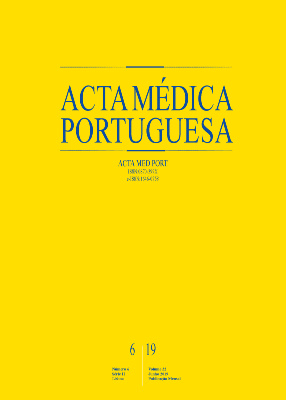Time-Trends in Cervical Cancer Mortality in Portugal
DOI:
https://doi.org/10.20344/amp.8921Keywords:
Mortality/trends, Portugal, Uterine Cervical Neoplasms/mortalityAbstract
Introduction: The mortality rate due to cervical cancer is higher in Portugal compared to other European countries. This study aimed to evaluate the time-trends in cervical cancer mortality rates observed in Portugal over the last six decades.
Material and Methods: Age-standardized cervical cancer mortality rates reported in Portugal between 1955 and 2014, were collected from the International Agency for Research on Cancer (IARC). Joinpoint regression analysis was used to identify significant changes in mortality rates by assessing the percentage of annual variation (%AV) of the rate and respective 95% confidence interval (95%CI) according to the age groups.
Results: Among women with 30–39 years, cervical cancer mortality decreased 1.9% per year (95%CI: –2.3; –1.4) throughout the time-period, reaching 0.5/100 000 in 2014. Among women aged 40–49 years, CC mortality decreased between 1971 and 1981 (%AV = –11.6; IC 95%: –14.6; –8.6). Rates then increased by 2.4% per year (95%CI: 1.0; 3.8) until 2001 and such trend reverted from 2001 onwards (%AV = –5.2; IC 95%: –7.7; –2.6), reaching 3.0/100 000 in 2014. In women aged 50–64, 65–74 and 75 years or older, cervical cancer mortality rates decreased from 29.2 to 6.7/100 000, from 34.3 to 7.7/100 000 and from 24.7 to 9.2/100 000. The decline in mortality rates in these three age groups occurred mainly between 1970 and 1980, and there have been no significant changes in the last three decades.
Discussion: In Portugal, the most impressive decline in cervical cancer mortality rates occurred in the 1970s concurrently with changes in the National Healthcare System. The most important changes were the increased access to early diagnosis and the improvement in therapeutic approaches. The plateau that we observed among older women over the last three decades can be partially explained by factors with negative impact on adherence to cervical screening.
Conclusion: There was a marked decrease in mortality due to CC among all age groups. However, we observed a plateau of this indicator in more advanced age groups over the last three decades. These findings suggest the need of promoting adherence to cervical screening in Portugal.
Downloads
Downloads
Published
How to Cite
Issue
Section
License
All the articles published in the AMP are open access and comply with the requirements of funding agencies or academic institutions. The AMP is governed by the terms of the Creative Commons ‘Attribution – Non-Commercial Use - (CC-BY-NC)’ license, regarding the use by third parties.
It is the author’s responsibility to obtain approval for the reproduction of figures, tables, etc. from other publications.
Upon acceptance of an article for publication, the authors will be asked to complete the ICMJE “Copyright Liability and Copyright Sharing Statement “(http://www.actamedicaportuguesa.com/info/AMP-NormasPublicacao.pdf) and the “Declaration of Potential Conflicts of Interest” (http:// www.icmje.org/conflicts-of-interest). An e-mail will be sent to the corresponding author to acknowledge receipt of the manuscript.
After publication, the authors are authorised to make their articles available in repositories of their institutions of origin, as long as they always mention where they were published and according to the Creative Commons license.









